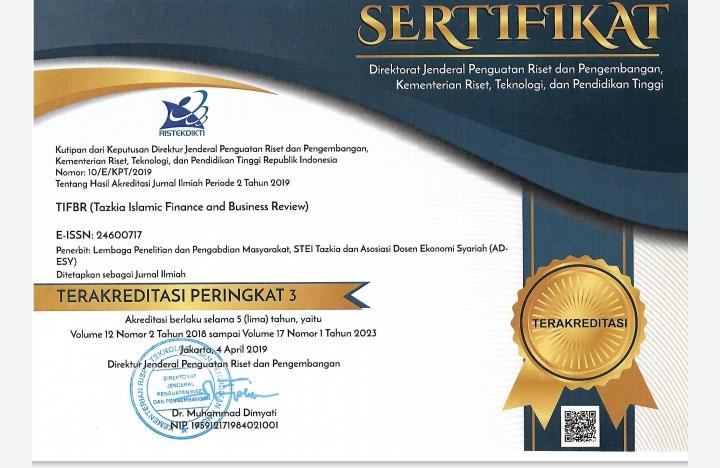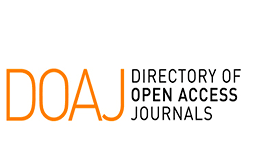Liquidity Management in Islamic Banking: Issues and Challenges
DOI:
https://doi.org/10.30993/tifbr.v12i2.148Keywords:
Islamic banking, liquidity, Islamic liquidity instrumentAbstract
As a financial intermediation, banking industry has and will always be bound with mismatch maturity problem between asset and liabilities which leads to liquidity issue. This article uses a literature study to observe the current liquidity trend in Islamic banking, the issues faced by the existing Islamic liquidity instruments and ways to overcome it. It is found that the common issues associated with Islamic liquidity instruments are sharia issue, inactivity of its secondary market, key issues on short term sukuk issuance and difficulty of cross-border transactions. A better management on liquidity position and a more robust liquidity infrastructure are needed for a better liquidty management in Islamic banking industry.References
Abdullah, D. V. (2010). Liquidity Management in Institutions Offering Islamic Financial Services. In Second Islamic Financial Stability Forum, Vol. 14.
Ahmed, E. R., Yahaya, S., and Harashid, M. (2012). Shubuhat on Matter of Bai’alinah and Tawarruq. International Journal of Business and Technopreneurship, Vol. 2(1): 85-101.
Ahmed, H., and Aleshaikh, N. M. (2014). Debate on Tawarruq: Historical Discourse and Current Rulings. Arab Law Quarterly, Vol. 28(3): 278-294.
Ali, S. S. (2013). State of Liquidity Management in Islamic Financial Institutions. Islamic Economic Studies, Vol. 21(1): 63-98.
Amin, H. (2007). An Analysis of the Classical and Contemporary Juristic Opinions on Bay al-Dayn. Labuan e-Journal of Muamalat and Society, Vol. 1: 29-40.
Archer, S., and Karim, R. A. A. (2014). The IILM Short-term Sukūk for Liquidity Management: A Success Story in Enhancing Financial Stability. SEACEN Financial Stability Journal, Vol. 3: 11-23.
Bacha, O. I. (2008). The Islamic Inter Bank Money Market and a Dual Banking System: the Malaysian Experience. International Journal of Islamic and Middle Eastern Finance and Management, Vol. 1(3): 210-226.
Bech, M., and Keister, T. (2017). Liquidity Regulation and the Implementation of Monetary Policy. Journal of Monetary Economics, Vol. 92: 64-77.
Beck, T., Demirgüç-Kunt, A., and Merrouche, O. (2013). Islamic vs. Conventional Banking: Business Model, Efficiency and Stability. Journal of Banking and Finance, Vol. 37(2): 433-447.
BIS. (2009). International Framework for Liquidity Risk Measurement, Standards and Monitoring. Consultative Document, Basel Committee on Banking Supervision.
Bordeleau, É., and Graham, C. (2010). The Impact of liquidity on Bank Profitability (No. 2010, 38). Bank of Canada working paper.
Brown, M., Trautmann, S. T., and Vlahu, R. (2016). Understanding Bank-Run Contagion. Management Science, Vol. 63(7): 2272-2282.
Bryant, J. (1980). A Model of Reserves, Bank Runs, and Deposit Insurance. Journal of Banking and Finance, Vol. 4(4): 335-344.
Calomiris, C. W., and Gorton, G. (1991). The Origins of Banking Panics: Models, Facts, and Bank Regulation. In Financial Markets and Financial Crises: 109-174. University of Chicago Press.
Calomiris, C. W., and Mason, J. R. (1994). Contagion and Bank Failures During the Great Depression: The June 1932 Chicago Banking Panic (No. w4934). National Bureau of Economic Research.
Comptroller of the Currency (2001). Liquidity: Comptroller’s Handbook. Comptroller of the Currency: Administrator of the National Banks. Washington, DC.
Dar, H. A., and Presley, J. R. (2000). Lack of Profit Loss Sharing in Islamic Banking: Management and Control Imbalances. International Journal of Islamic Financial Services, Vol. 2(2): 3-18.
Deloit. (2011). Deloitte Middle East Islamic Financial Survey: Benchmarking Practices.
Diamond, D. W., and Dybvig, P. H. (1983). Bank Runs, Deposit Insurance, and Liquidity. Journal of political economy, Vol. 91(3): 401-419.
El-Gamal, M. A. (2006). Islamic Finance: Law, Economics and Practice. Cambridge: Cambridge University Press.
Eljelly, A. M. (2004). Liquidity‐Profitability Tradeoff: An Empirical Investigation in an Emerging Market. International Journal of Commerce and Management, Vol. 14(2): 48-61.
Elliott, D. J. (2014). Bank Liquidity Requirements: An Introduction and Overview. The Brookings Institution.
Gholamreza, Z., Ariffin, N. M., and Shahabi, A. (2012). Some Issues on Murabahah Practices in Iran and Malaysian Islamic Banks. African Journal of Business Management, Vl. 6(24): 7066-7073.
Gomes, T., and Khan, N. (2011). Strengthening Bank Management of Liquidity Risk: The Basel III Liquidity Standards. Bank of Canada Financial System Review, Vol. 5: 35-42.
Härle, P., et al. (2010). Basel III and European Banking: Its Impact, How Banks Might Respond, and The Challenges of Implementation. EMEA Banking: 16-17.
Hayali, A., Sarili, S., and Dinc, Y. (2012). Turkish Experience in Bank Shareholders’ Fraud and Bank Failure: Imar Bank and Ihlas Finans Case. The Macrotheme Review, Vol. 1(1): 115-129.
Hong, H., Huang, J. Z., and Wu, D. (2014). The Information Content of Basel III Liquidity Risk Measures. Journal of Financial Stability, Vol. 15: 91-111.
IFSB. (2017). Background. Retrieved from: http://www.ifsb.org/background.php. December 18, 2017
IFSB. (2017). Basel III Regulatory Reforms and Islamic Finance discussed
at the 15th Islamic Financial Stability Forum. Retrieved from : http://www.ifsb.org/press_full.php?id=384andsubmit=more. December 18, 2017
IIMM. (2017). Yearly Islamic Interbank Transactions. Retrieved from: http://iimm.bnm.gov.my/index.php?ch=15andpg=86. December 18, 2017.
Ismon, N. Y. B. (2012). Legality of Tawarruq in Islamic Finance. Tazkia Islamic Finance and Business Review, Vol. 7(1).
Kashyap, A.K., Rajan, R. and Stein, J.C. (2002). Banks as Liquidity Providers: An Explanation for The Coexistence of Lending and Deposit-taking. The Journal of Finance, Vol. 57(1): 33-73.
Kusuma, K. A., and Silva, A. C. (2014). Sukuk Markets: a Proposed Approach for Development. The World Bank.
Majid, A., and Rais, A. (2003, March). Development of Liquidity Management Instruments: Challenges and Opportunities. In International Conference on Islamic Banking: Risk Management, Regulation and Supervision, held in Jakarta Indonesia September.
Mirakhor, A., Krichene, N., and Shaukat, M. (2012). Unsustainability of the Regime of Interest-Based Debt Financing. ISRA International Journal of Islamic Finance, Vol.4(2): 25-52.
Muranaga, J. and Ohsawa, M. (2002). Measurement of Liquidity Risk in the Context of Market Risk Calculation. Working Paper, Institute for Monetary and Economic Studies, Bank of Japan, Tokyo.
Ndiaye, H. S. F. Y. N. D. (2017). Issues with the Use of Tawarruq in
Malaysia. Journal of Islamic Banking and Finance, Vol. 5(2): 30-36.
Noor, A., and Azli, R. (2009). A Review of Islamic Credit Card Using Bay' al-'Inah and Tawarruq Instrument as Adopted by Some Malaysian Financial Institution. Retrieved July 24, 2016, from http://www.maybank2u.com.my/iwov-resources/islamicmy/document/my/en/islamic/scoe/knowledgecentre/researchpaper/A_Review_of_ Islamic_Credit.pdf
Nymag. (2017). A History of Bank Runs. Retrieved November 29, 2017 http://nymag.com/news/intelligencer/topic/banks-2012-6/
Olagunju, A., David, A. O., and Samuel, O. O. (2012). Liquidity Management and Commercial Banks' Profitability in Nigeria. Research Journal of Finance and Accounting, Vol. 2(7-8): 24-38.
Onal, M. (2013). Islamic Liquidity Management: The Way Forward.
Postlewaite, A., and Vives, X. (1987). Bank Runs as an Equilibrium Phenomenon. Journal of Political Economy, Vol. 95(3): 485-491.
Samad, A., and Hassan, M. K. (1999). The Performance of Malaysian Islamic Bank During 1984-1997: An Exploratory Study. International Journal of Islamic Financial Services, Vol. 1(3): 1-14.
Shearman and Sterling. (2011). The New Basel III Framework: Implications for Banking Organizations. Financial Institutions Advisory and Financial Regulatory.
Sobol, I. (2013). Liquidity Management Practices in Islamic Banking. Zarządzanie i Finanse, Vol. 2(1): 1.
Sole, M. J. (2007). Introducing Islamic Banks into Conventional Banking Systems (No. 7-175). Working paper, International Monetary Fund.
The Economist. (2017). The Bank that Failed. Retrieved November 28, 2017 from http://www.economist.com/node/9832838
Wahid, M. A., and Dar, H. (2016). Stability of Islamic Versus Conventional Banks: A Malaysian Case. Jurnal Ekonomi Malaysia, Vol. 50(1): 111-132.
Waldo, D. G. (1985). Bank Runs, the Deposit-currency Ratio and the Interest Rate. Journal of Monetary Economics, Vol. 15(3): 269-277.
Ahmed, E. R., Yahaya, S., and Harashid, M. (2012). Shubuhat on Matter of Bai’alinah and Tawarruq. International Journal of Business and Technopreneurship, Vol. 2(1): 85-101.
Ahmed, H., and Aleshaikh, N. M. (2014). Debate on Tawarruq: Historical Discourse and Current Rulings. Arab Law Quarterly, Vol. 28(3): 278-294.
Ali, S. S. (2013). State of Liquidity Management in Islamic Financial Institutions. Islamic Economic Studies, Vol. 21(1): 63-98.
Amin, H. (2007). An Analysis of the Classical and Contemporary Juristic Opinions on Bay al-Dayn. Labuan e-Journal of Muamalat and Society, Vol. 1: 29-40.
Archer, S., and Karim, R. A. A. (2014). The IILM Short-term Sukūk for Liquidity Management: A Success Story in Enhancing Financial Stability. SEACEN Financial Stability Journal, Vol. 3: 11-23.
Bacha, O. I. (2008). The Islamic Inter Bank Money Market and a Dual Banking System: the Malaysian Experience. International Journal of Islamic and Middle Eastern Finance and Management, Vol. 1(3): 210-226.
Bech, M., and Keister, T. (2017). Liquidity Regulation and the Implementation of Monetary Policy. Journal of Monetary Economics, Vol. 92: 64-77.
Beck, T., Demirgüç-Kunt, A., and Merrouche, O. (2013). Islamic vs. Conventional Banking: Business Model, Efficiency and Stability. Journal of Banking and Finance, Vol. 37(2): 433-447.
BIS. (2009). International Framework for Liquidity Risk Measurement, Standards and Monitoring. Consultative Document, Basel Committee on Banking Supervision.
Bordeleau, É., and Graham, C. (2010). The Impact of liquidity on Bank Profitability (No. 2010, 38). Bank of Canada working paper.
Brown, M., Trautmann, S. T., and Vlahu, R. (2016). Understanding Bank-Run Contagion. Management Science, Vol. 63(7): 2272-2282.
Bryant, J. (1980). A Model of Reserves, Bank Runs, and Deposit Insurance. Journal of Banking and Finance, Vol. 4(4): 335-344.
Calomiris, C. W., and Gorton, G. (1991). The Origins of Banking Panics: Models, Facts, and Bank Regulation. In Financial Markets and Financial Crises: 109-174. University of Chicago Press.
Calomiris, C. W., and Mason, J. R. (1994). Contagion and Bank Failures During the Great Depression: The June 1932 Chicago Banking Panic (No. w4934). National Bureau of Economic Research.
Comptroller of the Currency (2001). Liquidity: Comptroller’s Handbook. Comptroller of the Currency: Administrator of the National Banks. Washington, DC.
Dar, H. A., and Presley, J. R. (2000). Lack of Profit Loss Sharing in Islamic Banking: Management and Control Imbalances. International Journal of Islamic Financial Services, Vol. 2(2): 3-18.
Deloit. (2011). Deloitte Middle East Islamic Financial Survey: Benchmarking Practices.
Diamond, D. W., and Dybvig, P. H. (1983). Bank Runs, Deposit Insurance, and Liquidity. Journal of political economy, Vol. 91(3): 401-419.
El-Gamal, M. A. (2006). Islamic Finance: Law, Economics and Practice. Cambridge: Cambridge University Press.
Eljelly, A. M. (2004). Liquidity‐Profitability Tradeoff: An Empirical Investigation in an Emerging Market. International Journal of Commerce and Management, Vol. 14(2): 48-61.
Elliott, D. J. (2014). Bank Liquidity Requirements: An Introduction and Overview. The Brookings Institution.
Gholamreza, Z., Ariffin, N. M., and Shahabi, A. (2012). Some Issues on Murabahah Practices in Iran and Malaysian Islamic Banks. African Journal of Business Management, Vl. 6(24): 7066-7073.
Gomes, T., and Khan, N. (2011). Strengthening Bank Management of Liquidity Risk: The Basel III Liquidity Standards. Bank of Canada Financial System Review, Vol. 5: 35-42.
Härle, P., et al. (2010). Basel III and European Banking: Its Impact, How Banks Might Respond, and The Challenges of Implementation. EMEA Banking: 16-17.
Hayali, A., Sarili, S., and Dinc, Y. (2012). Turkish Experience in Bank Shareholders’ Fraud and Bank Failure: Imar Bank and Ihlas Finans Case. The Macrotheme Review, Vol. 1(1): 115-129.
Hong, H., Huang, J. Z., and Wu, D. (2014). The Information Content of Basel III Liquidity Risk Measures. Journal of Financial Stability, Vol. 15: 91-111.
IFSB. (2017). Background. Retrieved from: http://www.ifsb.org/background.php. December 18, 2017
IFSB. (2017). Basel III Regulatory Reforms and Islamic Finance discussed
at the 15th Islamic Financial Stability Forum. Retrieved from : http://www.ifsb.org/press_full.php?id=384andsubmit=more. December 18, 2017
IIMM. (2017). Yearly Islamic Interbank Transactions. Retrieved from: http://iimm.bnm.gov.my/index.php?ch=15andpg=86. December 18, 2017.
Ismon, N. Y. B. (2012). Legality of Tawarruq in Islamic Finance. Tazkia Islamic Finance and Business Review, Vol. 7(1).
Kashyap, A.K., Rajan, R. and Stein, J.C. (2002). Banks as Liquidity Providers: An Explanation for The Coexistence of Lending and Deposit-taking. The Journal of Finance, Vol. 57(1): 33-73.
Kusuma, K. A., and Silva, A. C. (2014). Sukuk Markets: a Proposed Approach for Development. The World Bank.
Majid, A., and Rais, A. (2003, March). Development of Liquidity Management Instruments: Challenges and Opportunities. In International Conference on Islamic Banking: Risk Management, Regulation and Supervision, held in Jakarta Indonesia September.
Mirakhor, A., Krichene, N., and Shaukat, M. (2012). Unsustainability of the Regime of Interest-Based Debt Financing. ISRA International Journal of Islamic Finance, Vol.4(2): 25-52.
Muranaga, J. and Ohsawa, M. (2002). Measurement of Liquidity Risk in the Context of Market Risk Calculation. Working Paper, Institute for Monetary and Economic Studies, Bank of Japan, Tokyo.
Ndiaye, H. S. F. Y. N. D. (2017). Issues with the Use of Tawarruq in
Malaysia. Journal of Islamic Banking and Finance, Vol. 5(2): 30-36.
Noor, A., and Azli, R. (2009). A Review of Islamic Credit Card Using Bay' al-'Inah and Tawarruq Instrument as Adopted by Some Malaysian Financial Institution. Retrieved July 24, 2016, from http://www.maybank2u.com.my/iwov-resources/islamicmy/document/my/en/islamic/scoe/knowledgecentre/researchpaper/A_Review_of_ Islamic_Credit.pdf
Nymag. (2017). A History of Bank Runs. Retrieved November 29, 2017 http://nymag.com/news/intelligencer/topic/banks-2012-6/
Olagunju, A., David, A. O., and Samuel, O. O. (2012). Liquidity Management and Commercial Banks' Profitability in Nigeria. Research Journal of Finance and Accounting, Vol. 2(7-8): 24-38.
Onal, M. (2013). Islamic Liquidity Management: The Way Forward.
Postlewaite, A., and Vives, X. (1987). Bank Runs as an Equilibrium Phenomenon. Journal of Political Economy, Vol. 95(3): 485-491.
Samad, A., and Hassan, M. K. (1999). The Performance of Malaysian Islamic Bank During 1984-1997: An Exploratory Study. International Journal of Islamic Financial Services, Vol. 1(3): 1-14.
Shearman and Sterling. (2011). The New Basel III Framework: Implications for Banking Organizations. Financial Institutions Advisory and Financial Regulatory.
Sobol, I. (2013). Liquidity Management Practices in Islamic Banking. Zarządzanie i Finanse, Vol. 2(1): 1.
Sole, M. J. (2007). Introducing Islamic Banks into Conventional Banking Systems (No. 7-175). Working paper, International Monetary Fund.
The Economist. (2017). The Bank that Failed. Retrieved November 28, 2017 from http://www.economist.com/node/9832838
Wahid, M. A., and Dar, H. (2016). Stability of Islamic Versus Conventional Banks: A Malaysian Case. Jurnal Ekonomi Malaysia, Vol. 50(1): 111-132.
Waldo, D. G. (1985). Bank Runs, the Deposit-currency Ratio and the Interest Rate. Journal of Monetary Economics, Vol. 15(3): 269-277.
Downloads
Published
2018-09-04
Issue
Section
Articles
License

Tazkia Islamic Finance and Business Review (TIFBR) is licensed under a Creative Commons Attribution-NonCommercial 4.0 International License.
Authors who publish with this journal agree to the following terms:
- Authors retain copyright and grant the journal right of first publication with the work simultaneously licensed under a Creative Commons Attribution License that allows others to share the work with an acknowledgment of the work's authorship and initial publication in this journal.
- Authors are able to enter into separate, additional contractual arrangements for the non-exclusive distribution of the journal's published version of the work (e.g., post it to an institutional repository or publish it in a book), with an acknowledgment of its initial publication in this journal.
- Authors are permitted and encouraged to post their work online (e.g., in institutional repositories or on their website), as it can lead to productive exchanges, as well as earlier and greater citation of published work (See the Effect of Open Access).















